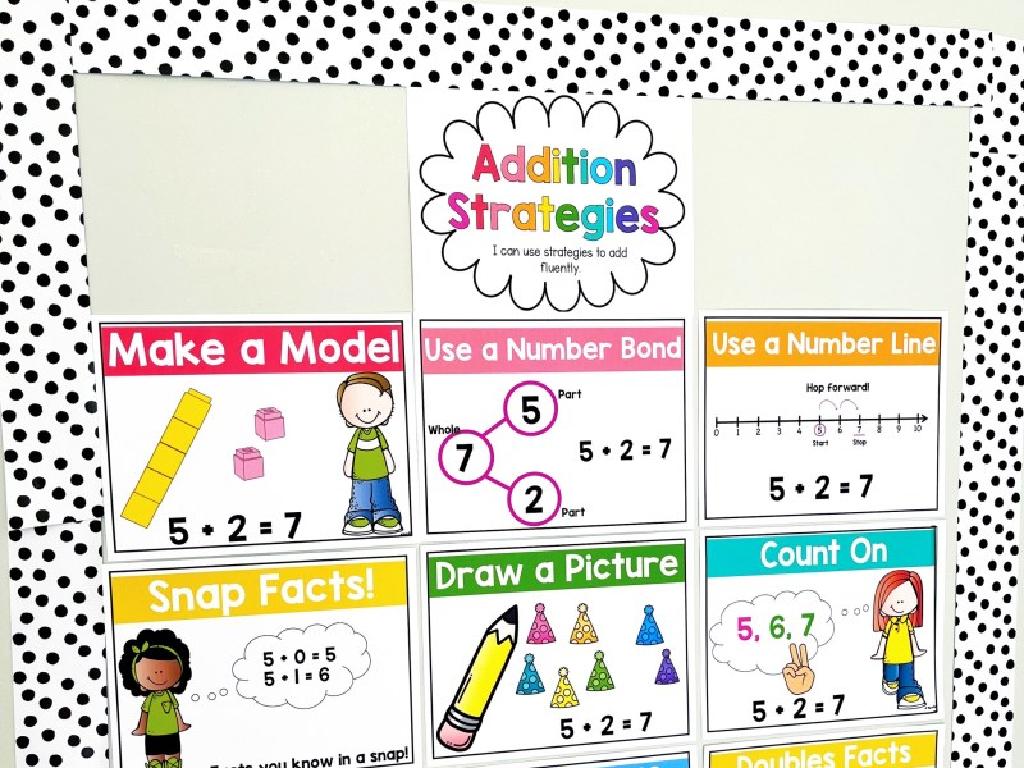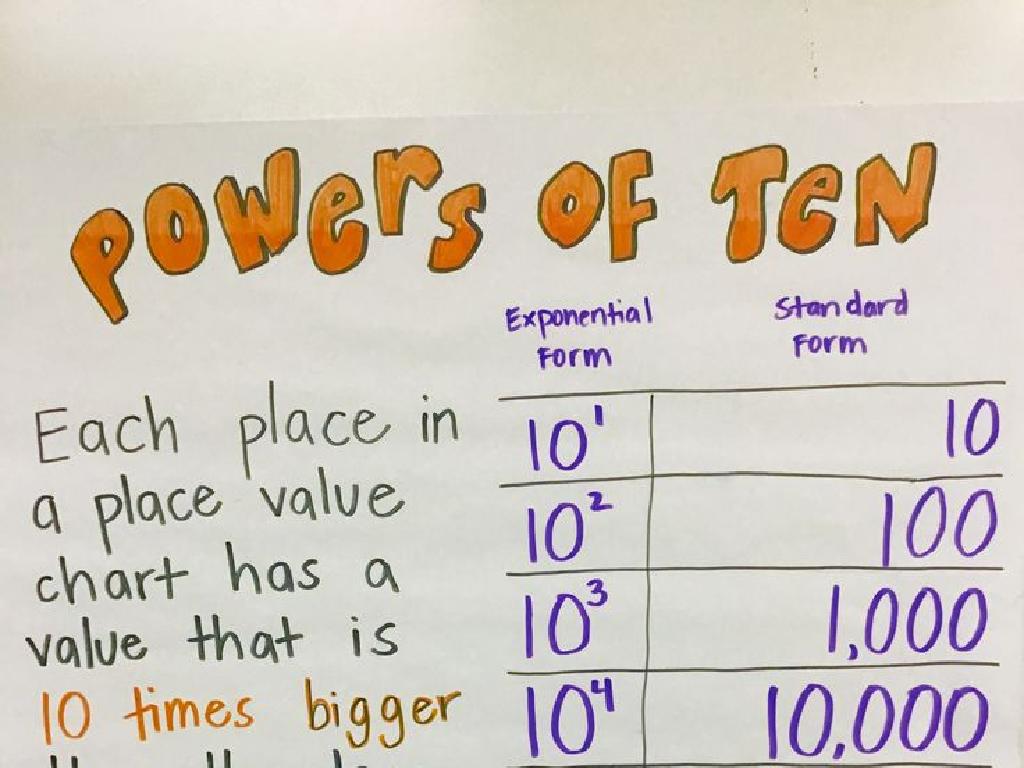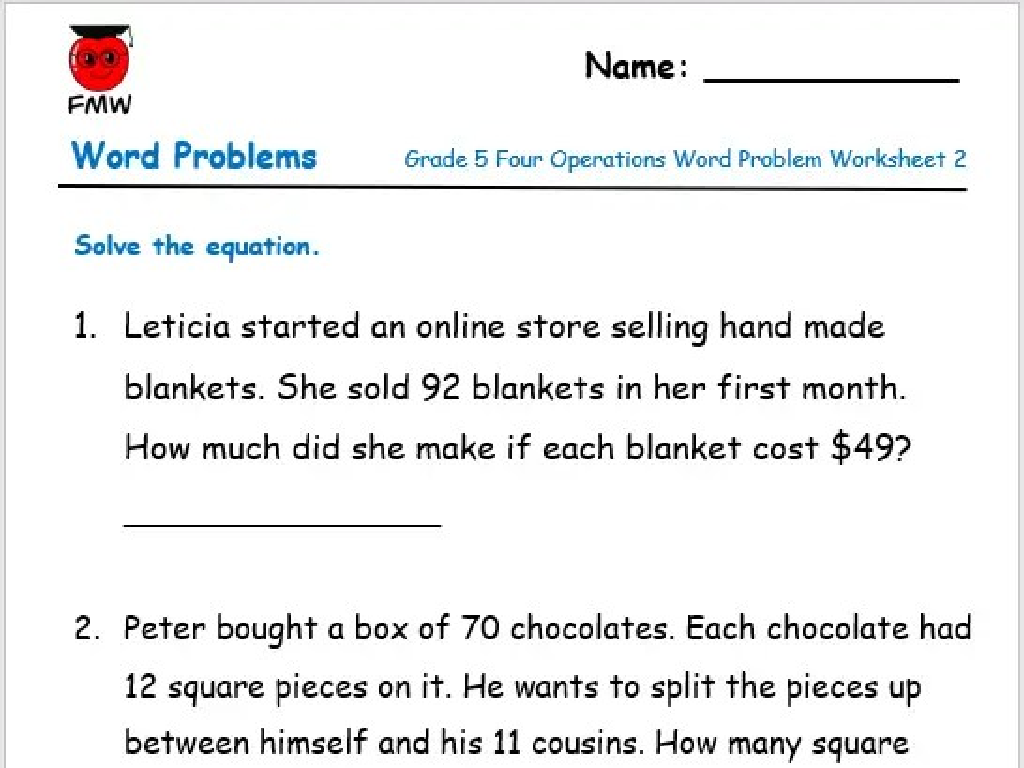Perimeter: Word Problems
Subject: Math
Grade: Fourth grade
Topic: Perimeter
Please LOG IN to download the presentation. Access is available to registered users only.
View More Content
Welcome to Perimeter Exploration!
– Perimeter: A shape’s boundary length
– It’s the total length around a 2D shape, like adding up all sides of a rectangle.
– Perimeter’s role in real life
– Perimeter helps in everyday tasks like fencing a yard or laying out a garden.
– Measuring perimeters in practice
– Use a ruler or a tape measure to find the length of each side and add them up.
– Importance of learning perimeter
|
Today’s lesson introduces the concept of perimeter, which is the total length around a two-dimensional shape. Understanding perimeter is crucial as it applies to many real-world situations, such as determining the amount of materials needed for a project or planning the layout of objects. Students will learn how to measure the sides of various shapes and calculate their perimeters using addition. Emphasize the practicality of this skill by discussing how professionals like architects and carpenters use perimeter in their work. Encourage students to think of and share their own examples where they believe perimeter could be important.
Exploring Perimeter through Word Problems
– Perimeter: total distance around
– It’s like measuring the fence around a yard.
– Calculate by adding all sides
– If a rectangle has sides of 4m and 6m, add 4+4+6+6.
– Measured in meters, inches, feet
– Choose the right unit based on the problem’s context.
– Practice with real-world problems
– How long is the ribbon needed to wrap a gift box?
|
This slide introduces the concept of perimeter to fourth-grade students, emphasizing its practical applications. Begin by explaining perimeter as the total length of the boundary of a shape. Use everyday examples like fencing a yard to make it relatable. Show how to calculate perimeter by adding the lengths of all sides, using simple shapes like rectangles and squares as examples. Discuss the importance of measurement units and when to use each. Finally, encourage students to solve real-world problems, such as finding the length of a ribbon to wrap a gift, to apply what they’ve learned about perimeter.
Perimeter of a Rectangle
– Perimeter: Total distance around
– Rectangle Perimeter Formula: P = 2(l + w)
– P is perimeter, l is length, w is width
– Example: Rectangle with l=5 cm, w=3 cm
– How to find perimeter with given length and width?
– Calculate: P = 2(5 cm + 3 cm)
– P = 2(8 cm) = 16 cm is the perimeter
|
This slide introduces the concept of perimeter as it applies to rectangles. Start by explaining that the perimeter is the total distance around the shape. Then, present the formula for finding the perimeter of a rectangle, P = 2(l + w), where P stands for perimeter, l for length, and w for width. Use a concrete example with a length of 5 cm and a width of 3 cm to show how to apply the formula. Walk the students through the calculation step by step, emphasizing the importance of adding the length and width first before multiplying by 2. This will help them understand the process of finding the perimeter of any rectangle they may encounter in word problems.
Perimeter of a Square
– Perimeter: total distance around
– Square Perimeter Formula: P = 4s
– s represents the length of a side
– Example: Square side 4 cm
– How long is each side of your square?
– Calculate: P = 4 x 4 cm
– Multiply the side length by 4 to find P
|
This slide introduces the concept of perimeter as it applies to squares. Begin by explaining that the perimeter is the total distance around the outside of a shape. Then, present the formula for finding the perimeter of a square (P = 4s), where ‘s’ is the length of one side of the square. Use the example of a square with a side length of 4 cm to show how to apply the formula in a practical situation. Have students calculate the perimeter by multiplying the given side length by 4. This will result in a perimeter of 16 cm. Encourage students to practice with squares of different side lengths and to check their understanding by solving additional problems.
Let’s Solve a Perimeter Problem!
– Understand the problem
– Identify all sides of the shape
– Count each side of the given shape
– Add lengths of all sides
– Use addition for all side lengths
– Find the total Perimeter
– Perimeter is the sum of all sides
|
This slide is designed as a class activity to practice finding the perimeter of a shape. Start by reading the problem together and ensure students understand what is being asked. Have them identify and count each side of the shape provided in the problem. Then, guide them to add the lengths of all sides together. Remind them that the perimeter is the total distance around the shape. For the activity, provide a shape with labeled side lengths and work through the problem as a class. Afterward, give students different shapes to calculate the perimeter individually or in groups. Possible activities include finding the perimeter of their desks, a book, or a section of the schoolyard.
Solving Perimeter Word Problems
– Understand the problem’s context
– Identify all side lengths given
– Look for clues for each side’s measurement
– Apply the perimeter formula
– Add up all the side lengths: P = sum of sides
– Solve and check your answer
– Ensure the solution makes sense in the problem’s context
|
This slide is aimed at teaching students how to approach and solve word problems involving the perimeter. Start by reading the problem thoroughly to understand what is being asked. Next, identify the lengths of all sides mentioned in the problem. Then, use the appropriate perimeter formula, which is the sum of the lengths of all sides for polygons. For rectangles, use P = 2(length + width) and for squares, use P = 4(side length). After calculating, encourage students to check if their answer is reasonable and fits within the context of the problem. Provide examples of different shapes and ensure students practice with problems of varying difficulty.
Let’s Solve Together: Perimeter Word Problem
– Example: Find the garden’s perimeter
– Garden length is 8m, width is 6m
– Recall the perimeter formula
– Perimeter formula is 2*(length + width)
– Apply the formula to solve
– Perimeter = 2*(8m + 6m) = 28 meters
– Discuss our solution steps
|
This slide is an interactive class activity designed to engage students in solving a perimeter word problem. Start by presenting the problem of finding the perimeter of a garden with given dimensions. Guide the students to recall the formula for the perimeter of a rectangle, which is 2 times the sum of the length and width. Then, apply the formula step by step with the class, calculating the perimeter as 2*(8m + 6m) to get 28 meters. Encourage students to explain each step and how they arrived at the solution. This reinforces their understanding of the concept of perimeter and how to apply it to solve real-world problems. Provide additional similar problems for practice and ensure to praise their efforts to boost confidence.
Class Activity: Perimeter Hunt
– Find classroom objects to measure
– Work in pairs for measurement
– Calculate the perimeter found
Add all sides to find the total perimeter
– Share findings with the class
|
This interactive activity is designed to help students apply their knowledge of perimeter in a practical setting. Have the students work in pairs to foster teamwork and ensure that they can help each other with measurements and calculations. Provide them with measuring tapes or rulers. Encourage them to select objects of various shapes to measure, such as books, tables, or even the classroom itself. After measuring, guide them to add all the side lengths to calculate the perimeter. Once they have recorded their findings, ask each pair to present their results to the class, discussing any challenges they faced and how they overcame them. Possible variations of the activity could include measuring window frames, the border of bulletin boards, or creating shapes with string to measure.
Wrapping Up: Perimeter Mastery
– Recap today’s perimeter lesson
– Practice is key to success
– Regular practice strengthens understanding
– Homework: 5 word problems
– Use the worksheet to solve problems
– Bring questions next class
|
As we conclude today’s lesson, it’s important to emphasize the value of practice in mastering perimeter calculations. The homework assignment involves solving five perimeter word problems, which will help reinforce the concepts learned in class. Encourage students to attempt the problems independently, but also to seek help if they encounter difficulties. Remind them to bring any questions they have to the next class for clarification. This will not only help them understand the topic better but also prepare them for more complex geometry in the future.






